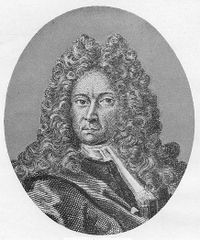Difference between revisions of "Category:Enochic Studies--1700s"
| Line 26: | Line 26: | ||
*[[:Category:Second Temple Studies--1700s|Second Temple Studies in the 1700s]] | *[[:Category:Second Temple Studies--1700s|Second Temple Studies in the 1700s]] | ||
*[[:Category:Enochic Studies--1700s|Enochic Studies in the 1700s]] | |||
*[[:Category:Historical Jesus Studies--1700s|Historical Jesus Studies in the 1700s]] | *[[:Category:Historical Jesus Studies--1700s|Historical Jesus Studies in the 1700s]] | ||
Revision as of 13:52, 12 April 2014
Enochic Studies in the 1700s--Works and Authors
< ... -- 1400s -- 1500s -- 1600s -- 1700s -- 1800s -- 1850s -- 1900s -- 1910s -- 1920s -- 1930s -- 1940s -- 1950s -- 1960s -- 1970s -- 1980s -- 1990s -- 2000s -- 2010s -- ... >
Overview
In the 18th century, the interest of scholars remained focused on the Enoch fragments of Syncellus, which provided the only textual evidence for 1 Enoch. They were published in the works of Scipione Sgambati (Archivorum veteris testamenti, 1703), and Johann Albert Fabricius (Codes pseudepigraphus Veteris Testamenti, 1713-23). The Fragments were translated into French (Pierre Jurieu, Histoire critique des dogmes et des cultes, 1704), German (Johann Christian Nehring, Neun Bücher Sibyllinischer Prophezeyungen, 1719), and partly, in English (A Universal History, vol.1, 1747; translated into Italian in 1765).
In 1710 Pompeo Sarnelli authored the first commentary on the surviving portions of the Book the Watchers. Nicolas Antoine Boulanger and Paul-Henri Thiry d'Holbach used the Syncellus fragments in their work on Enoch (1762).
Interest in Enoch remained strong in esoteric circles, and deeply influenced the development of Fremasonry. In his Histoire de la philosophie hermétique (1742) Nicolas Lenglet Du Fresnoy repeated the claim that the secret knowledge given by the fallen angels survived the Flood through the teachings of Noah. In his view Hermes Trismegistus was the the son of Mezraim, son of Ham, son of Noah, therefore a direct descendent of Enoch.
In 1773 the explorer James Bruce finally reached Ethiopia and brought back three copies of the Ethiopic version of the whole 1 Enoch. One copy was presented to King Louis XV of France and ended in the Bibliothèque Nationale de Paris; a second was given to the Bodleian Library in Oxford; and the third was retained by Bruce for himself, being added to the Bodleian collections only after his death in 1794.
The mss brought by Bruce were the first mss to be studied and published. Already in 1774 the Oxonian Coptic scholar, Charles Godefroy Woide, published a short note about the manuscript of Enoch he had seen in Paris. However, the mss brought by Bruce were not the only manuscripts of Ethiopic Enoch present in Europe at that time. At Rome there was indeed another copy of 1 Enoch, in the library of Card. Leonardo Antonelli; its provenance remains unknown, but it is likely that arrived in Rome before the Bruce mss were brought to Europe. In 1775 the Rome manuscript was examined by orientalist Agostino Antonio Giorgi, but remained untranslated and unpublished. Only several years after Antonelli's death, in the 1820s, it was purchased by Angelo Mai and became part of the collections of the Vatican Library (Biblioteca Apostolica Vaticana).
@2014 - Gabriele Boccaccini, University of Michigan
Related categories
Pages in category "Enochic Studies--1700s"
The following 16 pages are in this category, out of 16 total.
1
- Henochi historia ex Gen. 5 v. 21-24 repetita (1701 Schunck / Kesler), dissertation
- Archivorum Veteris Testamenti (1703 Sgambati), book
- Histoire critique des dogmes et des cultes (A Critical History of Dogmas and Cults / 1704 Jurieu), book
- Dissertation sur le Patriarche Hénoch (1719 Calmet), essay
- Neun Bücher Sibyllinischer Prophezeyungen (Nine Books of Sibylline Oracles / 1719 Nehring), book
- A Collection of Authentick Records Belonging to the Old and New Testament (1727-28 Whiston), book
- Ascension of Enoch (1728 Hoet), art
- De raptu Henochi et Eliæ in coelum (1739 Fischlin, Pfaff), dissertation
- Paradise Lost (1760 Smith / Stillingfleet), oratorio
- Dissertation sur Elie et Enoch (1762 Boulanger/Holbach), book
- Disputatio philologica de prophetia Henochi ex epist. Judæ v. XIV. (1769 Rezelius / Sommelius), dissertation
- De libro Henochi prophetico (1769 Sandmarck, Sommelius), dissertation
- De pietate & fatis Enochi (1789 Heber / Rost), dissertation
Media in category "Enochic Studies--1700s"
The following 2 files are in this category, out of 2 total.
- 1710 * Sarnelli.jpg 128 × 224; 8 KB
- 1713 Fabricius.jpg 326 × 500; 30 KB



